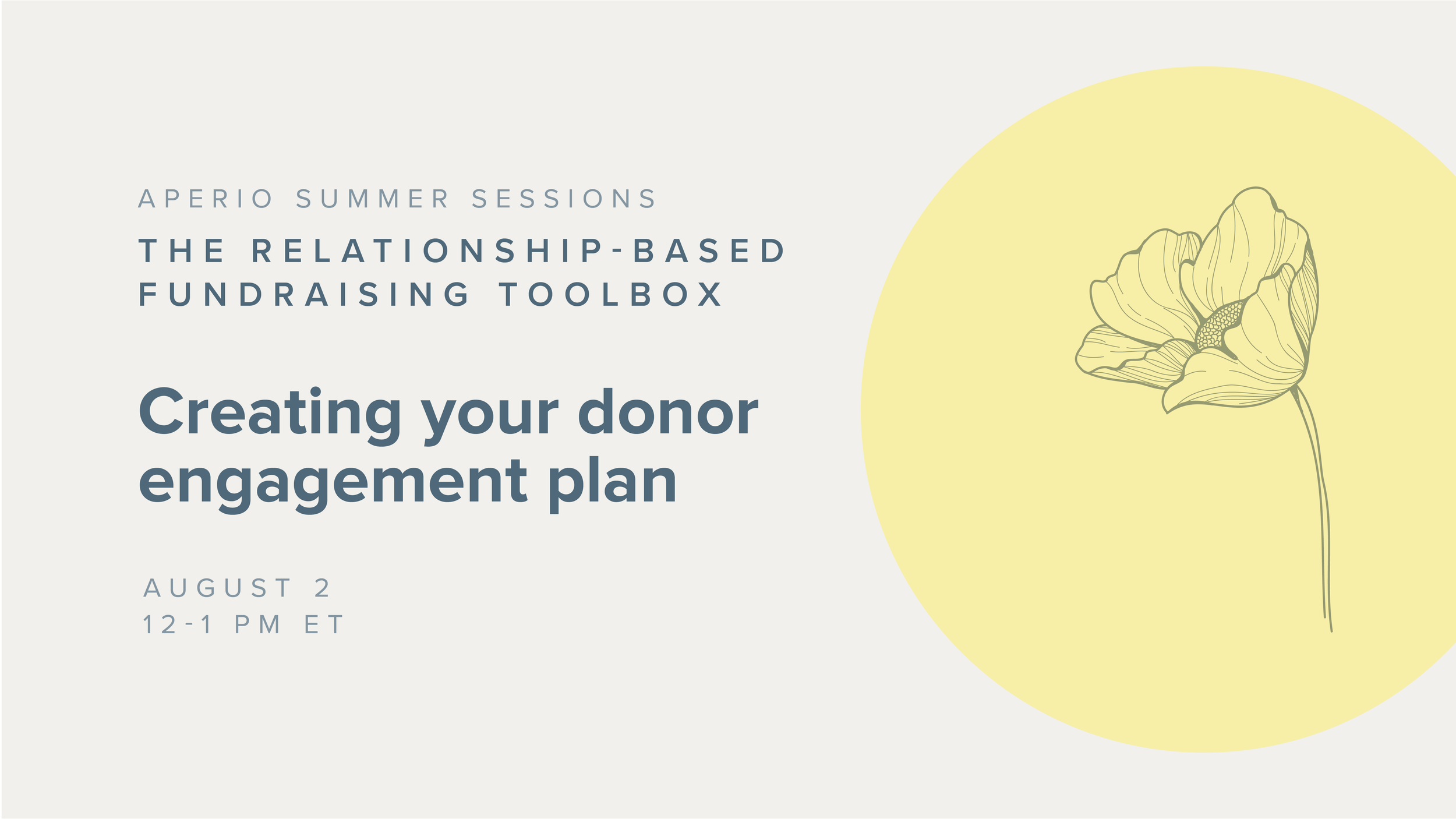Creating your donor engagement plan · Aperio summer sessions: The relationship-based fundraising toolbox
In the first of our three-part Aperio summer sessions: The relationship-based fundraising toolbox series, led by Aperio Senior Directors Kelly Braunegg and Toni Koch, we discussed how to organize and segment your list and the ways in which your database has more potential to support that process.
In this second session, we took the next step in stitching it all together: how to create a donor engagement plan—that is, to create an efficient, effective way to consistently bring your organization’s ‘why’ to each of your donor segments. We discussed:
What a donor engagement plan is
How to create your donor engagement plan
How to use your newly-created plan
Watch the full event recording on YouTube.
Why create a plan?
Internally or from your organization’s perspective, an engagement plan combined with an organized list, which we discussed last week ensures that:
No donor falls through the cracks
All donors are treated well (but not necessarily equally)—meaning that you create special opportunities for donors as they grow in their impact on your mission
Everyone on the team knows their part and is playing it so that engagement is simple and seamless, and it’s not a confusing hassle to get each mailing out or each cultivation event planned
Externally, and more importantly, the donor will feel, all the time, that:
Their gifts are being used well and as they intended
Their partnership makes a difference
They see a role for themselves in the future of the mission
How to create your plan
Before you get into the nitty-gritty of planning, take some time to get creative. Pull together your colleagues for a brainstorming session.
Make the most comprehensive list you can imagine by answering the following questions:
What are all the ways we can acknowledge & thank a donor for their giving? Meaning what can I do to show gratitude immediately following a gift?
What are all the ways we can recognize & celebrate their generosity? In other words, how can I continue to demonstrate that gratitude throughout the year?
What are all the ways we can show them the impact of their gift? Meaning, how can I communicate that donors’ gifts are being used as they intended?
What are ways we can help them experience the mission firsthand? Or how can we bring our mission to life for donors?
What are all the ways we can connect them to our community and create a sense of belonging? In other words, what opportunities do we have for donors to engage with each other?
Once you have your list, then you can think about what to do now and what you might be able to implement in the future.
Lastly, select a handful of experiences to add to your plan: it’s better to start with what you know you can do and add on as you bring on additional staff or outsource elements of your plan. Taking on what you know you can do effectively will help ensure your goals for developing the plan are met.
Now, it’s time to create the plan.
Your stewardship or engagement plan will have two pieces:
The first piece is an acknowledgement & recognition plan, in which we map out what a donor should receive based on their gift size this year. When we work on acknowledgement & recognition, we’re thinking of exclusivity—meaning we're reserving special touches for our largest donors. Having an acknowledgement plan is an opportunity to go beyond the tax letter and layer on additional touchpoints.
The second piece is a donor experience plan, in which we add on more experiences, based on a donor’s segment—or potential for future growth. When we work on donor experiences, we’re thinking of inclusivity—bringing as many potential donors into the family as we can, while ensuring efficiency and high ROI on resource and time-intensive touchpoints.
[Watch the full event video for details on how to flesh out these plans]
As you develop your engagement plan, remember: Acknowledgement and recognition alone are not the full picture. To fully engage a donor and inspire ongoing, growing support, we need experiences.
We need to bring the donor opportunities to:
See the impact of their giving
Experience the mission first-hand
Connect with the community and feel a sense of belonging
How to use your plan
With your plan in place, it’s time to 'operationalize’ it, meaning: Define who, what, when, and how everything will be done.
Roll the plan out to your team, ensuring everyone is very clear on roles and responsibilities. Do this by meeting regularly and with everyone involved in the creation and execution of relevant elements of the plan and use this time to refresh your plan quarterly or as needed.
One last element of the plan is a calendar, which provides a birds-eye view of who gets what and when, creating a baseline experience for all donors, with the opportunity to layer on personal touchpoints for donors under management.
To use the calendar as a tool for implementing the plan, gather everyone who’s responsible for creating and coordinating elements of the plan together monthly to review what’s planned for the next three months. Make sure everything is on track.
We find that when organizations have a clear plan for donor engagement, it allows relationship managers to focus on 1 to 1 touchpoints, while donor relations staff handle everything that is 1 to few and 1 to many. It helps you work smarter, not harder, because it gives you a line of sight as to what is coming up. This allows you to leverage the energy you put into mass market communications for major donors to help them deepen their engagement with your mission.


